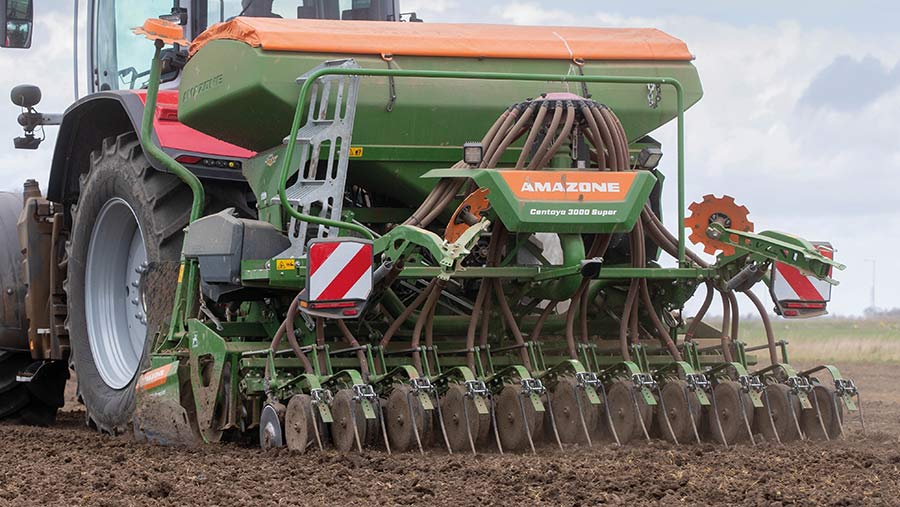Look beyond healthy harvest 2021 budget to address BPS cuts
 © Tim Scrivener
© Tim Scrivener High crop prices are making arable budgets look healthy, offering the chance to make changes that could be more difficult if left until BPS cuts bite deeper.
Consultant Andersons’ Loam Farm budget for harvest 2021 predicts the highest-ever business surplus for the 600ha model farm, at £430/ha, after accounting for variable costs, overheads, rent, finance, drawings and BPS income.
See also: Tips on controlling general farm overheads
High crop values are the main driver of this, as overheads have changed little. Yield expectations have been kept at the five-year average.
The budget has 40% of the 2021 wheat sold at between £160/t and £180/t ex-farm on a feed wheat price basis, with the remainder budgeted at £165/t.
Loam Farm – 2019 to 2022 harvests |
||||
|
(£/ha) |
2019 (result) |
2020 (result) |
2021 (estimated) |
2022 (forecast) |
|
Output |
1,314 |
1,165 |
1,379 |
1,332 |
|
Variable costs |
439 |
370 |
390 |
446 |
|
Gross margin |
875 |
795 |
989 |
886 |
|
Overheads |
442 |
436 |
437 |
454 |
|
Rent and finance |
239 |
238 |
242 |
242 |
|
Drawings |
79 |
75 |
78 |
78 |
|
Margin from production |
115 |
46 |
233 |
113 |
|
Basic payment |
230 |
233 |
197 |
162 |
|
Business surplus |
345 |
279 |
430 |
275 |
|
Source: Andersons |
||||
Machinery replacement put off
Like many, the farm reined back on machinery replacements in the tough conditions last year, and this year’s better predicted financial performance is needed to shore up the business.
“There is a bit of a danger that with good returns, changes will not be made,” said Andersons head of business research, Richard King. This could force changes further down the line that may be more sudden and more urgent, he warned. “If there are tighter times ahead, this year or next year may be the time to get kit up to scratch, where this is justified and not done for tax reasons.”
Next year is tighter, with another BPS cut taking the payment for the model farm down to £162/ha. And with slightly lower crop prices expected, the business surplus drops to £275/ha. Higher fertiliser and fuel prices will push up the cost of production, while postponed machinery spending for 2020 will need to be addressed, with a tractor and telehandler requiring replacing.
The 600ha model farm is all arable and is above average in terms of performance, but not in the top 25%. Half of the acreage is in feed and milling wheats, with 100ha each of spring barley, spring beans and winter oats.
The farm now has one-third of its acreage in spring cropping, helping control grassweed issues and spreading workload. Oilseed rape was dropped this year and the new rotation has reduced variable costs.
Lack of information on the Sustainable Farming Incentive means no income for this source has been included in the 2022 budget. “It’s dangerous to budget anything for that until we know what the payment rates are,” said Mr King. “There’s also the question of when any cash will arrive.”
Depreciation detail pays off
More accurate assessment of depreciation costs can aid business planning and avoid replacement cost shocks, said Mr King.
Depreciation is one of the most significant business costs. Rather than automatically using standard reducing balance or straight line methods of calculating depreciation, he suggested a more tailored approach by assessing the values of key pieces of kit annually.
“The calculation of accurate schedules of existing machinery depreciation, once a hugely time-consuming paper exercise, has become relatively quick and straightforward with the use of spreadsheets,” said Mr King.
“Assets can be individually identified and depreciation rates adjusted to reflect age, wear and tear or obsolescence, as well as the timing of replacements.”
This can help forecast and plan depreciation on a target-led basis. More accurate valuations can also give a better steer on replacement demands and help identify potential tax issues with the sale of second-hand kit.
